Acer R7 Review: Something Different
by Jarred Walton on August 15, 2013 12:45 AM ESTI’m going to stuff all of the benchmarks onto one page for this review; there’s really nothing noteworthy about the performance of the R7, at least on the CPU and graphics side of things. Battery life and display quality are a bit more important, but given the timeliness of this review (or the lack thereof), most of what we wanted to say was covered on the previous pages. So, here are the benchmarks, using our updated 2013 mobility suite. I’ll save a bit of short commentary for after the break.
First, here’s a quick overview of the laptops we’re including in our graphs. With the update to our 2013 mobile test suite, we’re somewhat at the mercy of our results database. Most of our comparisons that are meaningful are going to be with Ultrabooks, and given that were dealing with basically Ultrabook hardware the Acer R7 posts similar performance. We tossed in the MSI GX60 Richland APU notebook as a comparison, not because the notebooks are similar but because the A10-5750 APU more or less competes with Ivy Bridge ULV processors. Note that we did not run every benchmark on every laptop, so some charts might be missing certain laptops.
| Specifications of Benchmarked Laptops | ||||||
| Laptop | CPU | GPU | Storage | RAM | LCD | Battery |
| Acer R7-571-6858 | Intel Core i5-3317U | HD 4000 | 500GB HDD + 24GB SSD | 1x4GB + 1x2GB | 15.6” 1080p Glossy AHVA Touchscreen | 4-cell 54Wh |
| Acer S7-391-9886 | Intel Core i7-3517U | HD 4000 | 2x128GB RAID 0 SSDs | 2x2GB | 13.3” 1080p Glossy IPS Touchscreen | 4-cell 35Wh |
| Acer S7-392-9890 (Preview) | Intel Core i7-4500U | HD 4400 | 2x128GB RAID 0 SSDs | 2x4GB | 13.3” 1080p Glossy IPS Touchscreen | 4-cell 46Wh |
| AMD Kabini | AMD A4-5000M | HD 8330 | 256GB SSD | 1x4GB | 14” 1080p Matte IPS | 4-cell 45Wh |
| Apple MacBook Air 13 (2013) | Intel Core i5-4250U | HD 5000 | 128GB SSD | 2x2GB | 13.3” 1440x900 Glossy TN | 4-cell 54Wh |
| Clevo W550EU (Mythlogic) | Intel Core i5-3340M | HD 4000 | 256GB SSD | 2x4GB | 15.6” 1080p Matte IPS | 6-cell 62-Wh |
| HP Spectre XT TouchSmart | Intel core i7-3517U | HD 4000 | 500GB HDD + 32GB SSD | 2x4GB | 15.6” 1080p Glossy IPS Touchscreen | 4-cell 48Wh |
| Lenovo ThinkPad X1 Carbon | Intel Core i5-3427U | HD 4000 | 180GB SSD | 2x2GB | 14” 1600x900 Glossy TN Touchscreen | 4-cell 45Wh |
| MSI GE40 | Intel Core i7-4702MQ | HD 4600 / GTX 760M | 128GB SSD + 750GB HDD | 1x8GB | 14” 1600x900 Matte TN | 6-cell 65Wh |
| MSI GX60 | AMD A10-5750 | HD 8650G | 750GB HDD | 1x8GB | 15.6” 1080p Matte TN | 9-cell 87Wh |
| Toshiba KIRAbook | Intel Core i7-3537U | HD 4000 | 256GB SSD | 2x4GB | 13.3” 2560x1440 Glossy IPS Touchscreen | 4-cell 52Wh |
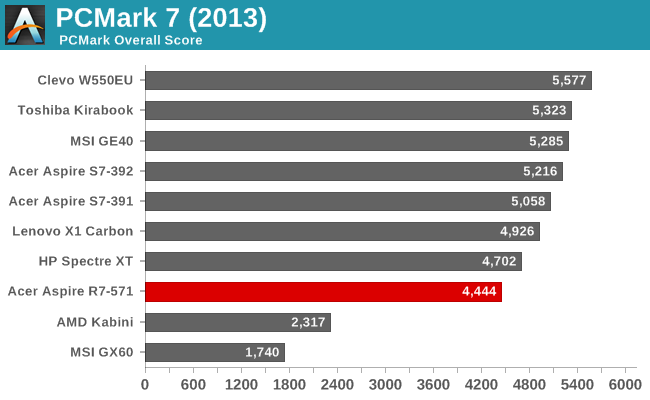
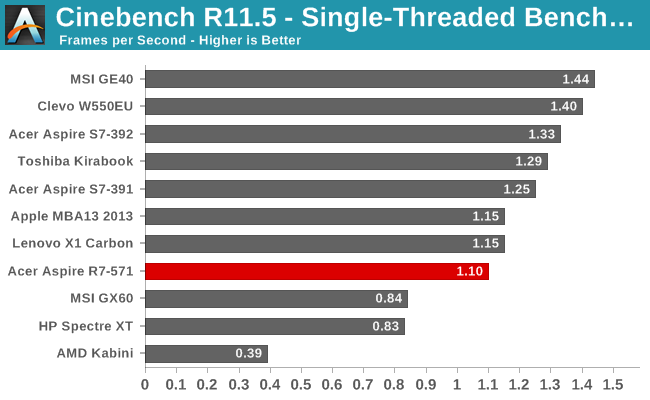
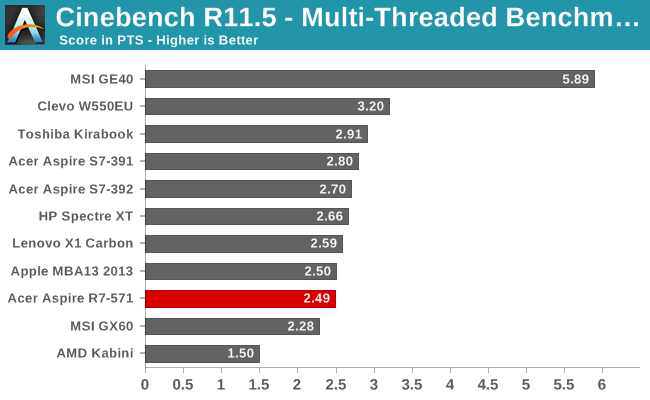
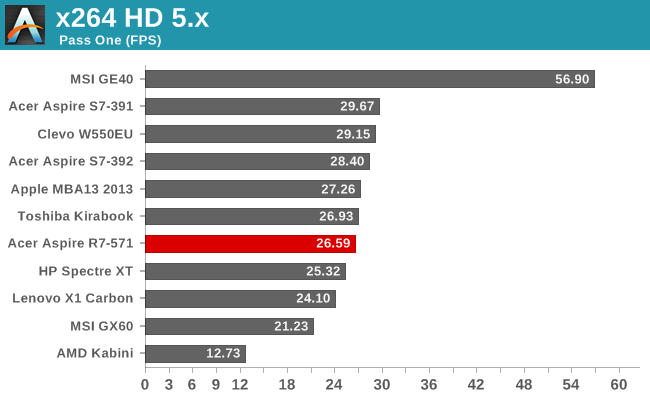
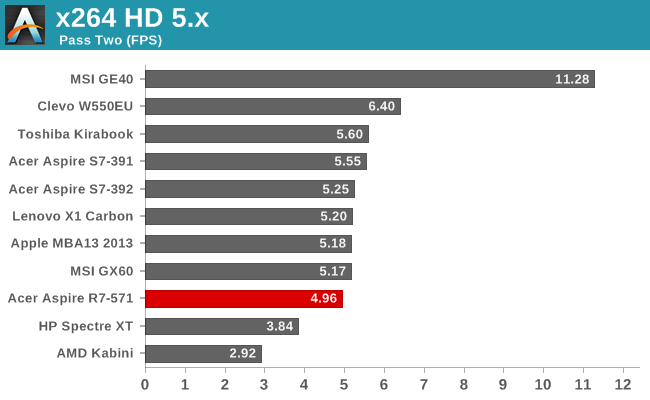
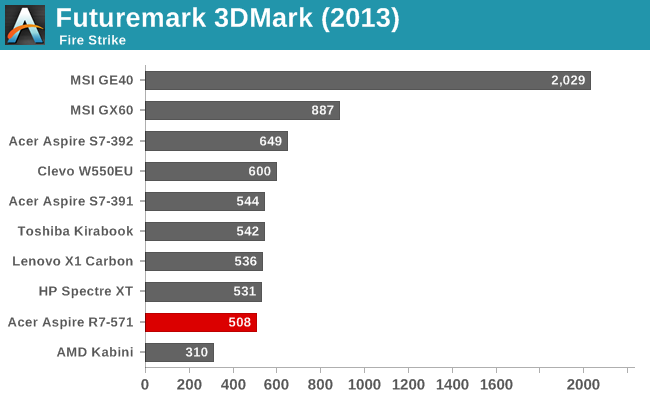


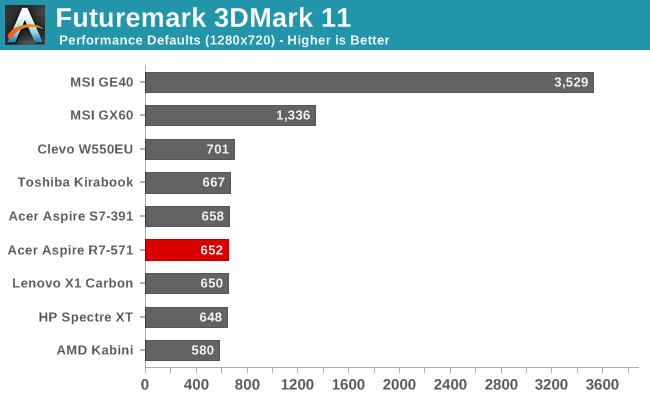
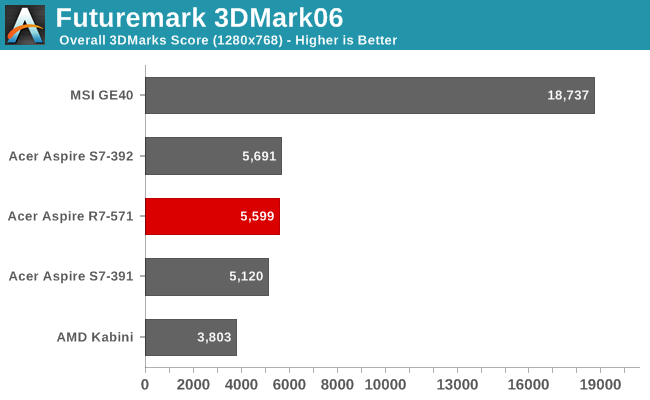

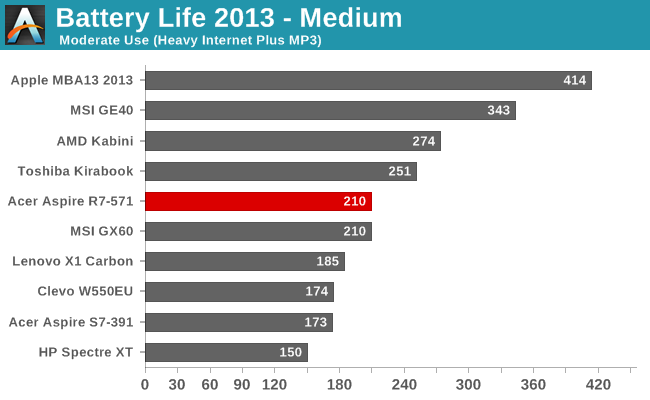
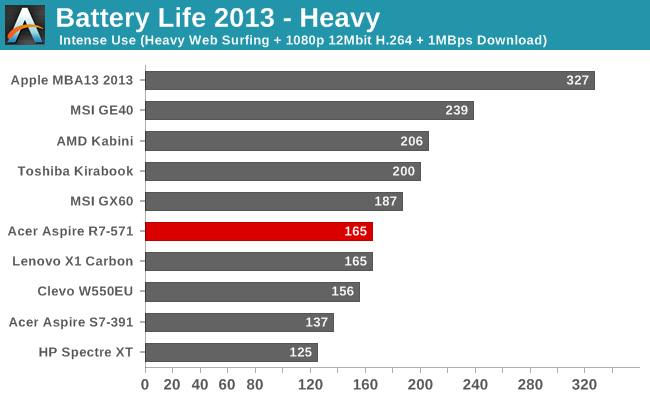
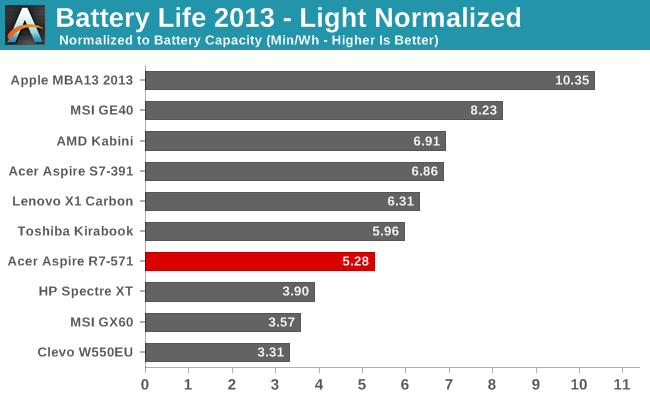
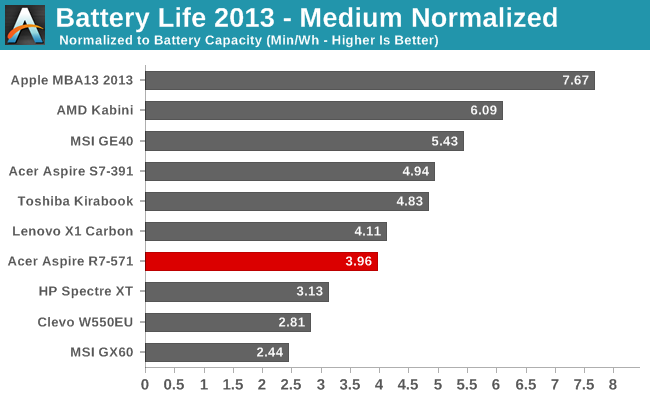
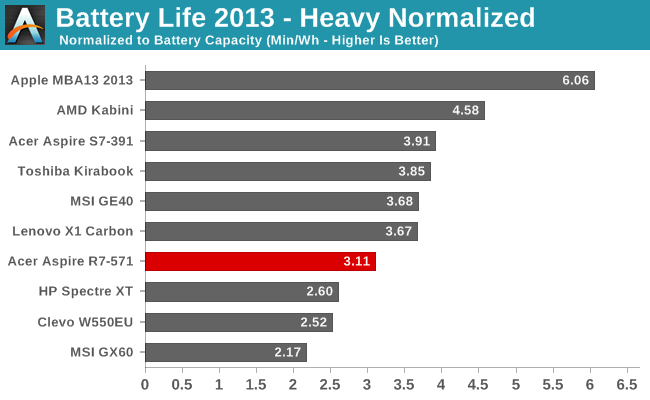
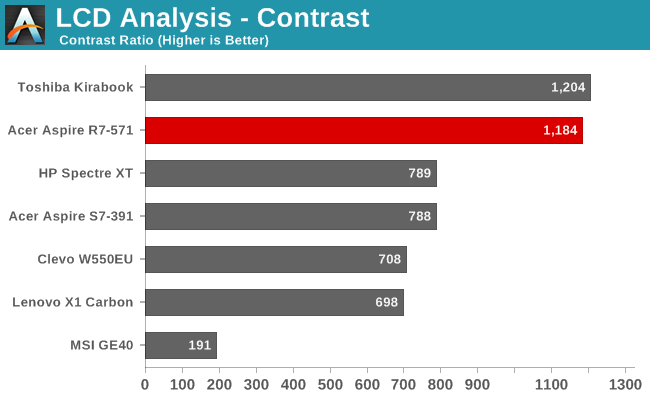

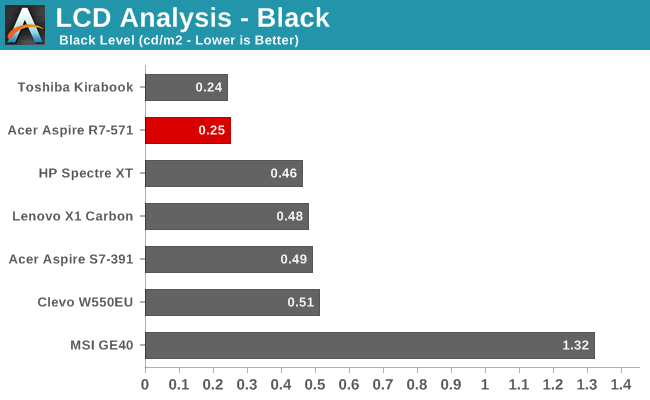
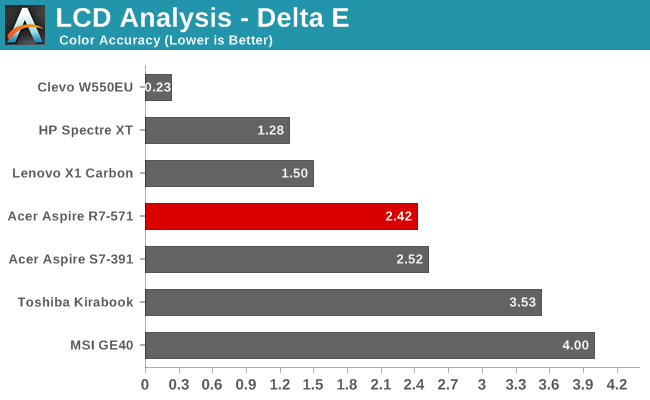
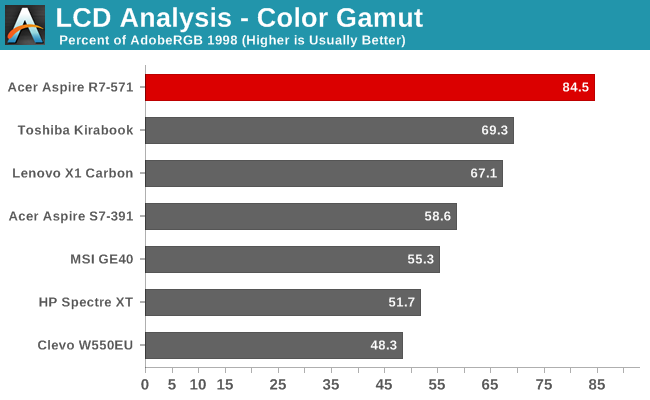
Whew! That’s a lot of benchmarks, and there are even more results in Mobile Bench – like if you really want to know how the R7 handles our gaming suite, for example, it’s there! If you don’t want to look but want a short summary, only one game gets above 10FPS at the Enthusiast settings, and just barely; with Mainstream most of the games fall in the 10-20FPS range, so basically unplayable. Even our Value gaming settings are mostly too much for the HD 4000, though most of the Windows 8 games in the Store are far less demanding and will run just fine – no surprise given most of those are targeting Windows RT, which means GPUs that are often less than half as fast as the HD 4000.
Elsewhere, CPU performance is about where you’d expect it: lower than Core i7 ULV/ULT, and similar to other Core i5 ULV parts. The hybrid storage solution means that PCMark7 doesn’t score quite as well as pure SSDs, but it’s still a huge step up from what you’d get from a pure HDD setup (e.g. GX60). Since I just mentioned the GX60, it’s also interesting to note that Core i5 ULV generally posts better CPU performance than AMD’s Richland APUs – though the second pass of x264 HD at least put AMD slightly ahead. GPU performance is nothing to write home about; it’s more than sufficient for running most Windows tasks, but anything graphically intensive is best off served by a dedicated GPU (or at the very least Intel’s Iris HD Graphics Iris Pro).
Battery life isn’t particularly stellar, but we’ve also seen worse – sometimes much worse. Realistically, four hours of light use is possible off a single charge, while heavier workloads will bring you closer to 2.5 hours. That puts the R7 slightly ahead of the Lenovo X1 Carbon in most tests, but only thanks to its higher battery capacity. In terms of normalized battery life, the R7 places fourth from last of the tested notebooks, and given that Clevo typically doesn’t optimized very well for power use and the MSI GX60 is classified as a gaming notebook, only the win over the HP Spectre XT TouchSmart is really worth mentioning. When we start to look at Haswell-based notebooks, even though Ivy Bridge was pretty good it looks pretty poor in light of what’s now available. Apple’s MacBook Air 13 runs at different OS, but the MSI GE40 has a quad-core Haswell CPU and a slightly larger battery, with about 50% more battery life than the Acer R7.
Wrapping up the benchmarks, as I mentioned before, the one standout item in the R7 is the display. Contrast is excellent, and color quality is at least decent – the 85% color gamut is actually a bit overblown, however, as some of the colors are actually outside of the Adobe RGB 1998 color space while others fall far short (green in particular is lacking). Still, the great viewing angles offered by AHVA combined with good overall performance definitely deserve commendation.










113 Comments
View All Comments
mooncancook - Thursday, August 15, 2013 - link
I tend to agree with you. I had been interested in convertible notebook and tried them out in store before, the experience was lacking. Then came Win8 and I tried the Sony Duo 11, I was intrigued, but I was turned off by the short battery life. Finally Haswell arrived, and I tried the new Sony Duo 13 and I was convinced and bought it. I love it so far. With traditional notebook, the only place that I use it is on a desk, but with a hybrid I start using it while lying on the couch or bed, and the touch browsing experience with IE is great. If I need more precise control I can use the Wacom-liked stylus or the built-in touchpad, and if I am seriously working on desktop mode I'd connect a BT mouse. It costs 4 times as much as a good tablet but it can be 10 times as useful. It is not for everyone but it opens new doors and new opportunities. On the other hand, I don't think a 15" hybrid that weighs over 5 lb is appealing. Overall I like what MS did to put serious touch capability into their new OS. Without Win8 and Haswell I would not have purchased a new hybrid notebook at all.Samus - Thursday, August 15, 2013 - link
This is obviously an opinion, but the Ezel hinge is a ridiculously stupid idea. Having the touchpad ABOVE the keyboard makes it basically useless (you are guaranteed to nudge keys with your wrists) and the ability to lay the open screen completely flat with the body of the machine doesn't exist. This is for a market that doesn't want a tablet, notebook, convertible, ultraportable, or DTR/powerhouse.frozentundra123456 - Thursday, August 15, 2013 - link
I agree. I see the only really useful hybrid formfactor to be a totally detachable tablet. Maybe something like the HP Split, I think it is. Even some of the cool hinged designs, like the dell (I cant remember the name) or the Lenovo Yoga are still basically laptops, and you are stuck with hauling around the keyboard all the time, and they are too heavy and bulky to easily be used as a tablet, even when folded into tablet form.So ultimately, the only convertible option I would choose would either be a tablet with a dock, or a laptop with a totally detachable tablet portion. Actually, I suppose those two are basically the same thing.
nerd1 - Thursday, August 15, 2013 - link
Actually the ezel hinge is the best option out there for convertible tablet, as it can be made quite sturdy, and can house the main logicboard (ativ Q does so). Vaio duo 13 uses the same architecture and managed to fit a small touchpad BELOW the keyboard to make it actually useful as a laptop.Samus - Thursday, August 15, 2013 - link
If they were going to put the logic board in there, then why not go all the way and make the screen detachable? Ohh, right, the battery. The whole implementation is poor. You get no real benefit over a laptop for double the price and a virtually unusable track pad.sheh - Thursday, August 15, 2013 - link
It seems the screen is 6-bit, without even FRC? Is there obvious dithering?JarredWalton - Thursday, August 15, 2013 - link
The only places that say it's 6-bit are not really reliable sources. I'm guessing most assume 6-bit since that's what all TN panels use, but this isn't TN. Sadly, AUO's page doesn't say anything: http://www.auo.com/?sn=149&lang=en-US&c=34...AHVA is a high-end technology, though, basically in the same category as IPS, so I'd be surprised if it was actually only 6-bit. In fact, other sources say AHVA can do 10-bit, but they're no more reliable than the places saying 6-bit. In use, I didn't see any signs of dithering, but then even dithering on TN panels has become good enough that I don't notice.
ZeDestructor - Thursday, August 15, 2013 - link
Just thought you should know: You can also get IPS panels with 6-bit (the well-known, much-liked Dell U2412M comes to mind, source: http://www.tftcentral.co.uk/reviews/dell_u2412m.ht... ).On that note, if you spend the money, you can get a damn good TN panel as well, as the 1920x1200 panel in my Dell E6500 shows. First time I powered it on, I mistook it for an MVA panel because it had rather good colour gamut (compared to my dual U2410 setup), with negligible colour shifting, little washout at 120° (60° each side).
ViperV990 - Thursday, August 15, 2013 - link
I can't stand the fused enter/backslash key design Acer has been employing.althaz - Thursday, August 15, 2013 - link
Because the Start Menu is actually complete rubbish. It's worthless, with only one redeeming feature (arriving in the much-maligned Windows Vista): Search.
The Start Screen is an order of magnitude better at everything except search. For search it can either be much better or a bit worse. The things that actually do need criticism in Windows 8 are the (entirely optional) swipe-ins (on the desktop accessed by the hot corners) and metro apps (which suck on a desktop and should not be the default apps for anything). On tablets those things are actually pretty great (Windows 8 on a tablet is a very long way ahead of Android/OS in terms of user experience, despite being somewhat unfinished). On touchscreen notebooks they are somewhat useful, but still slower than keyboard shortcuts.